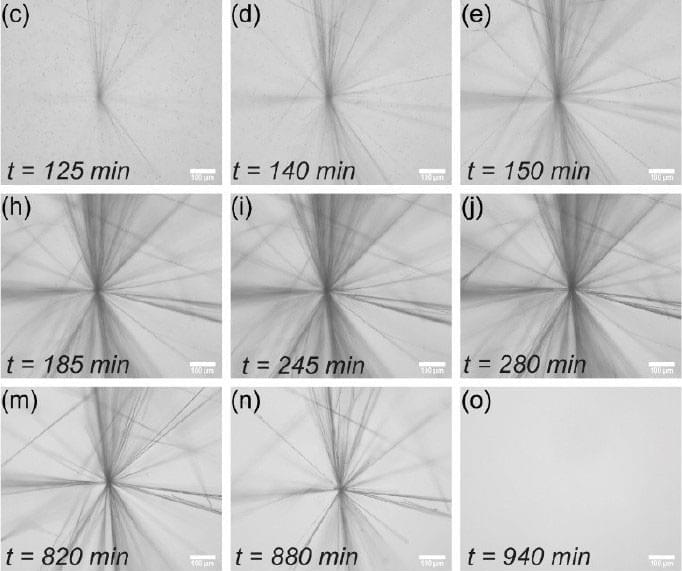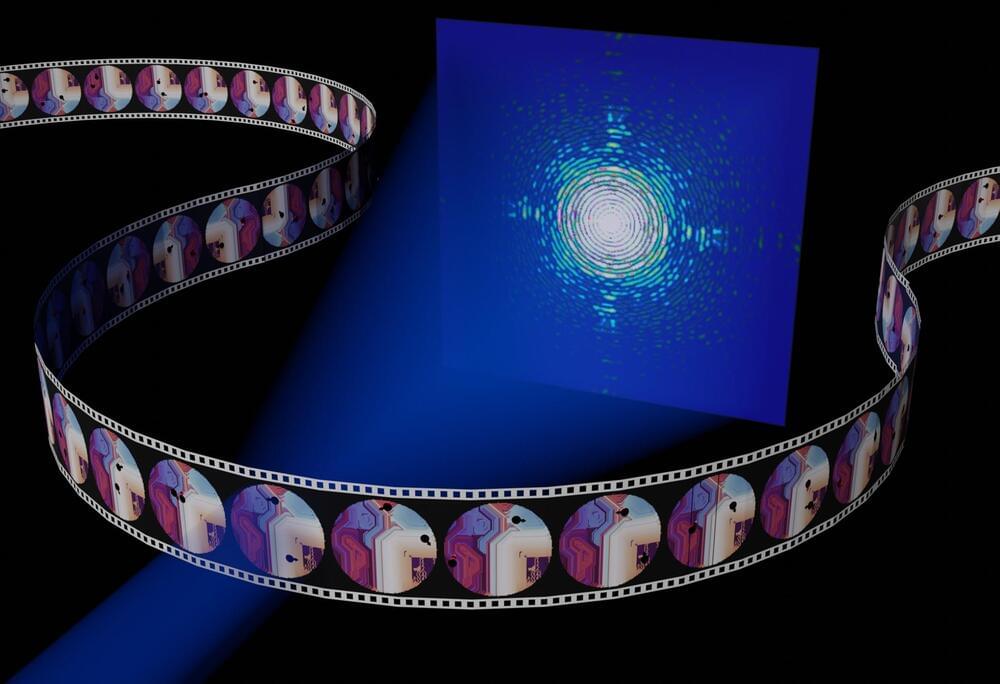Page 2
Sep 4, 2024
Systematic transcriptomic analysis and temporal modelling of human fibroblast senescence
Posted by Shubham Ghosh Roy in categories: biotech/medical, life extension
Cellular senescence is a diverse phenotype characterised by permanent cell cycle arrest and an associated secretory phenotype (SASP) which includes inflammatory cytokines. Typically, senescent cells are removed by the immune system, but this process becomes dysregulated with age causing senescent cells to accumulate and induce chronic inflammatory signalling. Identifying senescent cells is challenging due to senescence phenotype heterogeneity, and senotherapy often requires a combinatorial approach. Here we systematically collected 119 transcriptomic datasets related to human fibroblasts, forming an online database describing the relevant variables for each study allowing users to filter for variables and genes of interest. Our own analysis of the database identified 28 genes significantly up-or downregulated across four senescence types (DNA damage induced senescence (DDIS), oncogene induced senescence (OIS), replicative senescence, and bystander induced senescence) compared to proliferating controls. We also found gene expression patterns of conventional senescence markers were highly specific and reliable for different senescence inducers, cell lines, and timepoints. Our comprehensive data supported several observations made in existing studies using single datasets, including stronger p53 signalling in DDIS compared to OIS. However, contrary to some early observations, both p16 and p21 mRNA levels rise quickly, depending on senescence type, and persist for at least 8–11 days. Additionally, little evidence was found to support an initial TGFβ-centric SASP. To support our transcriptomic analysis, we computationally modelled temporal protein changes of select core senescence proteins during DDIS and OIS, as well as perform knockdown interventions. We conclude that while universal biomarkers of senescence are difficult to identify, conventional senescence markers follow predictable profiles and construction of a framework for studying senescence could lead to more reproducible data and understanding of senescence heterogeneity.
Multiple studies now suggest that the accumulation of senescent cells is causal in ageing (Childs et al., 2015; Mylonas and O’Loghlen, 2022; van Deursen, 2014; Wlaschek et al., 2021), and their ablation extends healthspan and mean lifespan in rodents (Baker et al., 2016; Baker et al., 2011). Novel senolytic and senostatic drugs are in development (Kim and Kim, 2019; Niedernhofer and Robbins, 2018) with some drugs in clinical trials (Hickson et al., 2019; Justice et al., 2019) which might shortly lead to treatments capable of improving healthspan and extending lifespan in humans. However, the exact nature of senescent cells is often difficult to define, with multiple studies indicating that the most common biomarkers of senescence show different profiles across cell lines, types of senescence inducer, and the timepoint after the initial stimulus (Avelar et al., 2020; Basisty et al., 2020; Casella et al., 2019; Hernandez-Segura et al., 2017; Neri et al., 2021).
Sep 4, 2024
New supercomputer coming to Round Rock
Posted by Genevieve Klien in category: supercomputing
ROUND ROCK, Texas (KXAN) — A new, multi-million dollar supercomputer is headed to Round Rock. The Texas Advanced Computing Center (TACC) at the University of Texas at Austin (UT) partnered with Sabey Data Centers for the project.
The supercomputer, dubbed “Horizon,” is expected to be online in 2026. The technology is part of a new, larger program from the National Science Foundation (NSF), which recently helped fund $457 million to UT to help bring the academic supercomputer to the area.
This team is on a roll.
Launching aboard Firefly’s Alpha vehicle in 2024, this mission will demonstrate the responsive on-orbit capabilities of our Elytra vehicle. As the first of many missions utilizing multiple Firefly vehicles, the demonstration will lay the groundwork for Firefly’s end-to-end mission solutions, proving our capabilities to rapidly launch, maneuver, and deploy satellites at a time and place of our customers’ choosing.
In support of Xtenti’s follow-on study contract with the NRO, the mission will demonstrate a rapid payload reconfiguration utilizing Xtenti’s FANTM-RiDE payload dispenser prior to launching on Firefly’s Alpha vehicle. Upon launching on Alpha, Firefly’s Elytra vehicle will utilize the FANTM-RiDE dispenser to first deploy commercial rideshare payloads in Sun-Synchronous Orbit, and then perform an on-orbit maneuver and stand ready to deploy U.S. government payloads on-demand.
Sep 4, 2024
When Cyber Security Breaches Are Inevitable, It’s Time To Call For A New Approach
Posted by Genevieve Klien in category: cybercrime/malcode
We need to do more than deflect cyberattacks. We must build the capacity to sustain operations during and after a cyberattack. We need to bounce back stronger than ever.
Sep 4, 2024
Designing a Futuristic Magnetic Turbine (MHD drive)
Posted by Quinn Sena in categories: 3D printing, media & arts, space travel

A solid state turbine may be the next evolution for marine travel, just like Novium is the next evolution of pens.
Enjoy 10% OFF and free shipping on all Hoverpens with code PLASMA:
North America \& other countries: https://bit.ly/plasma_novium.
UK \& Europe: https://bit.ly/plasma_noviumeu.
Learning from my first design, I created an improved marine thruster that uses magnetohydrodynamic thrust. It took the better part of a month, and plenty of tests. This really pushed my 3D printing skills to the limit, but it also lead to fully functional thruster that outperformed my expectations. Thanks to Onshape for their awesome modeling program. Create a free Onshape account here: https://Onshape.pro/PlasmaChannel.
First MHD thruster video here: • Using Stealth Propulsion for Ocean Tr…
Continue reading “Designing a Futuristic Magnetic Turbine (MHD drive)” »
Sep 4, 2024
The Influence of Psychedelics and Mind-Altering Substances in Ancient Rituals and Governance
Posted by Jose Ruben Rodriguez Fuentes in categories: governance, neuroscience
Throughout history, humans have sought to transcend the ordinary boundaries of consciousness, reaching for experiences beyond the everyday. They did this through various means, including the use of psychedelics and mind-altering substances. These substances have played a profound role in shaping ancient rituals, belief systems, and even governance. From the shamanic traditions of Siberia to the sophisticated ceremonies of the Maya, the use of psychoactive plants and compounds has been a ubiquitous feature of human culture. The influence of these substances extended far beyond mere spiritual exploration; they became intertwined with the very fabric of ancient societies, affecting political structures, social hierarchies, and religious practices. To fully understand their influence, we must study the intricate relationships between psychedelics, ritual practices, and governance in ancient civilizations, examining how these substances were used to achieve altered states of consciousness, connect with the divine, and wield power.
Visions From Beyond: The Role of Psychedelics in Ancient Rituals
Psychedelics have long been associated with religious and spiritual rituals, serving as gateways to the divine or as tools for gaining insight into the cosmos. In many ancient societies, these substances were not merely recreational but were integral to the religious experience, often seen as sacraments that enabled communication with gods or spirits.
Sep 4, 2024
Real-time control over a chemical reaction network by light
Posted by Dan Breeden in categories: chemistry, energy
Self-assembled molecules are responsible for important cellular processes. Self-assembled structures such as microtubules or actin filaments are key to cell motility: change of shape, division or extension of membranes. These self-assembled entities have the peculiarity of being formed temporarily, since they require energy consumption. Inspired by nature, there is currently an active area of research that attempts to replicate this process of self-assembly artificially, using the so-called chemical reaction networks.
The control of self-assembly by means of chemical reaction networks is based on the activation of a monomer prone to self-assembly, which is then deactivated. In this way, the self-assembled structure requires a continuous energy consumption to perpetuate itself. From a chemical point of view, this energy is provided by a “fuel”, a chemical reagent. Depending on the availability of that energy source, the self-assembly process occurs or not.
Traditionally, highly reactive fuels have been used to carry out the activation, with little control over the deactivation process. This also implies that the activation and deactivation fuels tend to react with each other, making artificial dissipative self-assembly processes ineffective. In nature, these two processes are controlled by catalysts, which increases their efficiency. Thus, the introduction of catalysts in these processes and the control of their activity by external stimuli such as light are highly desirable, since they can limit part of these problems.
Sep 4, 2024
A new method captures the stochastic dynamics in coherent X-ray imaging
Posted by Dan Breeden in categories: biological, chemistry, nanotechnology, space
Coherent X-ray imaging has emerged as a powerful tool for studying both nanoscale structures and dynamics in condensed matter and biological systems. The nanometric resolution together with chemical sensitivity and spectral information render X-ray imaging a powerful tool to understand processes such as catalysis, light harvesting or mechanics.
Unfortunately these processes might be random or stochastic in nature. In order to obtain freeze-frame images to study stochastic dynamics, the X-ray fluxes must be very high, potentially heating or even destroying the samples.
Also, detectors acquisition rates are insufficient to capture the fast nanoscale processes. Stroboscopic techniques allow imaging ultrafast repeated processes. But only mean dynamics can be extracted, ruling out measurement of stochastic processes, where the system evolves through a different path in phase space during each measurement. These two obstacles prevent coherent imaging from being applied to complex systems.
Sep 4, 2024
Can we solve quantum theory’s biggest problem by redefining reality?
Posted by Shubham Ghosh Roy in categories: particle physics, quantum physics
With its particles in two places at once, quantum theory strains our common sense notions of how the universe should work. But one group of physicists says we can get reality back if we just redefine its foundations.

















